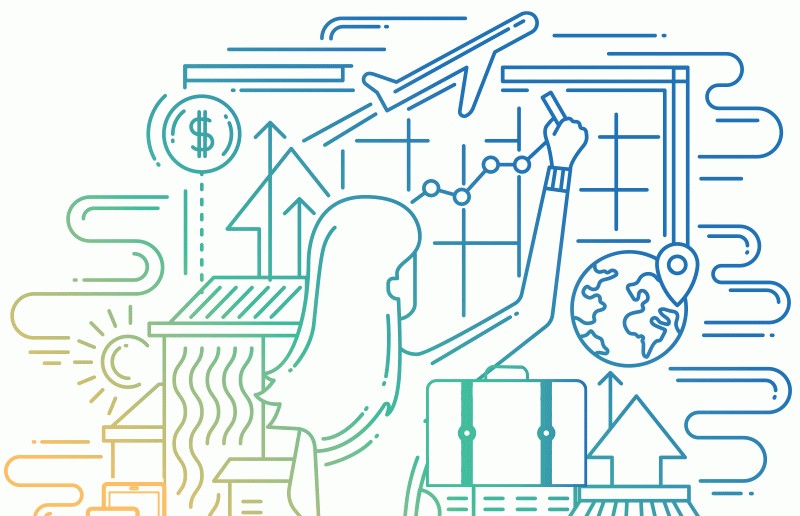There has never been a better time to travel with so many tools at our disposal. Smartphones make it possible to buy airline tickets and hotel reservations wherever we are and price alerts help us find the best deals.
But many of these advancements have given rise to new business challenges. Forming relationships with customers in a fragmented and highly competitive travel industry is increasingly difficult. Here are some areas where companies have simplified travel experiences, along with opportunities to further improve those experiences to drive customer loyalty:
Real-time planning
It’s unquestionable that the Internet transformed travel. Instead of relying on an associate to book reservations, consumers can do the research themselves and plan their own trips. Companies like Expedia and Priceline also consolidated information about flights and accommodations, allowing travelers to find all the essentials on one website.
Additionally, the ability for customers to find and share information online introduced more powerful word-of-mouth marketing, whereas the traditional marketing and branding techniques used by travel agencies had a limited reach.
“The biggest change since I started traveling full-time in 2007 has been smartphones,” says Gary Arndt, a blogger and photographer who chronicles his travels on his blog, Everything Everywhere. “You can now do so much with just a device in your pocket. And as international data roaming becomes more prevalent, there is more and more you can do.”
Smartphones have also ushered in the next phase of travel: last-minute planning. “Travel has evolved more into a last-minute decision-making and planning effort,” observes Stephen Solosky, a former math professor who started his own company, Traveling Professor, which takes tour groups to France, Italy, Peru, and other countries. “People seem to be making decisions on travel later and later and do less travel planning [which] is all made simpler in the digital age.”
Mobile apps like GTFO (Get The Flight Out) show spontaneous travelers flights that are leaving that night through the next morning from nearby airports. Hotel Tonight lets users find a place to stay on the same day they would like to check in. And restaurant reservation apps like Table8, DINR, and Velocity match same-day restaurant availabilities with last-minute diners.
Oh, the Places You'll Go!
The ways in which we plan our trips and journey to new destinations is constantly changing. Here’s a snapshot of innovations that are shaking up the travel industry.
The Challenge: Heavy baggage
Instead of towing your suitcase, imagine having it follow you around. A robotics company called CowaRobot designed a mobile suitcase that uses depth sensors and a set of sonar and cliff detection sensors to follow anyone who wears an accompanying bracelet. While you might want to hold on to your suitcase in a crowded public space, such a suitcase could come in handy when you’re loading up the car and your hands are full.
The Challenge: Language barriers
Companies continue to churn out faster and smarter translation apps. Google Translate will produce a text translation for anything that you type, speak, photograph, or draw on the touch screen. Waygo can translate Chinese, Japanese, and Korean characters from a photograph into an English translation. It will also store your translations so you can retrieve the message for later uses.
The Challenge: Environmentally friendly travel
For consumers concerned about the impact of their travels on the environment, it is becoming increasingly easier to stay green. Some airlines like United and Delta can calculate the dollar amount of a flight’s carbon footprint. Customers can then donate their money or miles to a carbon reduction project such as forest conservation or renewable energy.
Traveling with data
Daniel Noll, a full-time traveler who, along with his wife, blogs about their journeys on Uncornered Market, says that greater access to information has led to a “democratization of travel.” Nearly anyone today can plan a trip that meets their budget and leave at a moment’s notice. He adds that by the same token, though, the amount of choices an individual can make prior to and during a trip creates a “choice overload of sorts, whereby it can become overwhelming to the traveler, particularly as she experiences the fear of missing out (FOMO) or the buyer’s remorse of the feeling of having selected the ‘wrong’ option.”
In fact, the influx of travel options has spawned another market: Tools to help you sort through all that data. Advanced analytics and algorithms are being used to crunch data to identify the best time to book a flight or create a personalized travel agenda.
The fare-predicting app Hopper, for example, alerts users when there are fare sales from their home airport for destinations they might be interested in. The app also takes into consideration destinations you indicated an interest in and suggests similar destinations with more affordable flights.
Data behemoths like Google also offer tools for simplifying the process of planning a trip. The new Google Trips app pulls in data from Gmail, Google Maps, crowdsourced reviews, and other sources to offer recommendations in a personalized travel guide. Users type the name of a city they’re interested in, which pulls up colorful boxes that contain information with labels such as “Day Plans,” “Food and Drink,” “Getting Around,” and more. The app will also help you keep track of reservations that were sent to your Gmail account.
In addition to collecting information, the app can also make suggestions. As of this writing, Trips can show users the most popular day plans and itineraries for 200 cities worldwide. The information is based on reviews from other travelers, which Google has culled from its databases and assembled into lists. If you’re short on time, you can specify whether you only have time to sightsee in the morning or afternoon and mark your must-see places on a map. Trips will then fill in the rest of the allotted time for you with nearby sights.
A number of companies are also adding a social layer to travel planning. Trippy, for instance, is a crowdsourcing tool in which users follow a city to receive a feed of the community’s questions and answers about that city. If they follow a country, they will see all the questions and answers about that country, as well as the cities within that country. TripIt and its competitor, Wipolo, are tools that create an itinerary based on the reservation emails you’ve forwarded to them, and users can share their itineraries with their Facebook friends for feedback.
A look ahead
Despite all these online tools, there are still plenty of opportunities to further improve travel experiences. Car rentals, for instance, could be updated, Arndt says. “The process of checking in and getting a car is still very slow and outdated,” he says.
Solosky agrees. “I think ideas like... Uber have simplified travel and I would like to see that expanded,” he says. “How about applying the... Uber model to your car [in a long-term parking lot]? Why pay $15 a day for your car to sit in a lot for two weeks when you can rent it out to a traveler coming into a city?”
As a matter of fact, several startups are tackling car rentals. Founded in 2010, RelayRides was launched with the radical idea of car owners renting their cars to strangers for a few hours or a few days. Renters can even pick up the vehicle at an airport. It wasn’t long, however, before RelayRides faced competition from other companies like Uber, Lyft, and Car2Go, which also offered solutions for same-day car rentals.
The brand name RelayRides also became problematic. RelayRides emphasized the concept of ridesharing, which was becoming common in the rise of a sharing economy. The company was struggling to stand out. Therefore, in 2015, the company unveiled a new name, “Turo.” Whereas RelayRides represented ridesharing and peer-to-peer commerce, Turo “is about turning travel into adventure,” wrote Turo CEO Andre Haddad in a blog post.
The company, in other words, evolved to focus more on the driving experience and less on the idea of renting someone’s car. “It’s about the journeys you take, the roads you navigate, and the people you meet along the way,” Haddad wrote. “With Turo, the car you choose is part of a story, not a fleet.”
Ultimately, customers want an effortless, enjoyable travel experience. But as Turo noted, it’s not enough to get a customer from Point A to Point B. Product features and services are easily imitated and commodified. Especially in an industry as competitive and fragmented as travel, companies must stay ahead of the customer’s needs. Therefore, expect to see more companies that not only offer convenience and speed, but are attentive to how travelers’ expectations are evolving.















